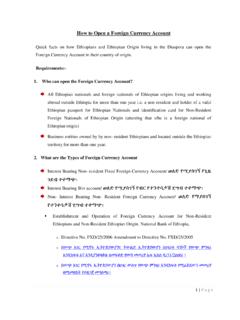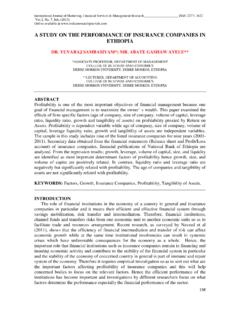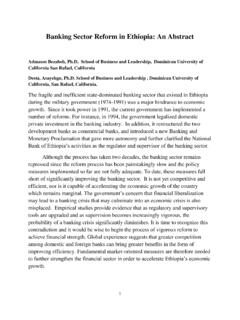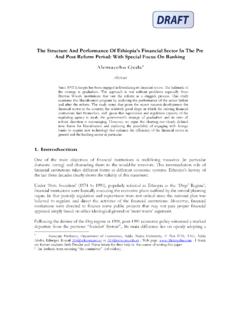Transcription of th Ethiopia Economic Update: OVERCOMING ... - …
1 4th Ethiopia Economic update : OVERCOMING constraints IN THE manufacturing SECTORP ublic Disclosure AuthorizedPublic Disclosure AuthorizedPublic Disclosure AuthorizedPublic Disclosure Authorized4th Ethiopia Economic UpdatEovErcoming constraints in thE manufacturing sEctorJuly 8, 2015iiiAcknowledgements ..vlist of AbbreviAtions ..viiexecutive summAry ..ixrecent Economic developments And outlook ..1 The Short View ..1 Real Sector ..1 Monetary Sector ..3 Financial Sector ..5 Fiscal Sector ..7 External Sector ..9 The Long View: The Effect of Falling Oil Prices on the Ethiopian Oil Price Developments ..13 Ethiopia s Oil Market ..13 Ethiopia s Oil Position ..14 Likely Impact of the Oil Price Decline ..14 Potential other Impacts of the Oil Price Decline ..16 The Future View: Outlook and Challenges ..19 Outlook ..19 Challenges ..20growth And trAnsformAtion through manufacturing .
2 23 Industrialization in Ethiopia ..23 Productivity and Skills for Development ..26 Productivity Benchmarking ..26 Skills and Productivity ..29 constraints for manufacturing Growth ..33 Access to Finance: Particular Challenge for SMEs ..35 Operational constraints ..40 Entry Barriers ..42 The Role of Industrial Parks and FDI for manufacturing Growth ..45 Rationale for Industrial Parks (IPs) ..45 Ethiopia s Experience with IPs so Far ..46tablE of contEnts4th Ethiopia Economic update OVERCOMING constraints in thE manufacturing sEctorivLessons Learned for IP s in Ethiopia : Design and Implementation ..49 Short Summary and Recommendations for manufacturing Development ..52 Annexes ..55 Annex 1: Ethiopia : Selected Economic Indicators (High Frequency) ..56 Annex 2: Ethiopia : Selected Economic and Social Indicators (Annual Frequency).
3 57references ..59list of figuresFigure : Economic Activity ..2 Figure : Monetary Sector ..4 Figure : Financial Sector ..6 Figure : Fiscal Sector ..8 Figure : External Sector ..10 Figure : Key Facts on Oil and Its Price Decline in Ethiopia ..17 Figure : Economic Outlook: Selected Projections to 2017 ..21 Figure : Real GDP Growth and Sector Contribution ..25 Figure : Productivity Benchmarking ..27 Figure : Education, Skills and Employment ..30 Figure : Top 10 Business Environment constraints ..34 Figure : Access to Finance for Enterprises ..36 Figure : Business Environment constraints Identified by Firms ..43 Figure : FDI inflows ..47list of tAblesTable : Assumption on the Maximum Pass-Through to Domestic Market of the Oil Price Decline ..15 Table : Macro-Fiscal Outlook Indicators, 2012 to 2017 ..22 Table : Employment by Sector.
4 24 Table : Unit Labor Cost (Wages-Productivity Ratio) in manufacturing , 2011 ..28 Table : Unemployment of TVET Graduates, Selected Training Areas, 2012 ..32 Table : Most Binding constraints to Doing Business in Ethiopia , Various Rankings ..33 Table : Structural constraints to Selected Light- manufacturing Sectors ..34 Table : Types of Collateral Used by : MSME Definitions by national MSE Development Strategy ..38list of boxesBox 1: China s secret weapon in light manufacturing : Small and Medium Enterprise-oriented Plug and Play industrial zones ..48vacknowlEdgEmEntsThe World bank greatly appreciates the close collaboration with the Government of Ethiopia (the Ministry of Finance and Economic Development, in particular) in the preparation of this report. The report was prepared by a team led by Michael Geiger (Sr.)
5 Country Economist, GMFDR) under the guidance of Lars Christian Moller (Lead Economist and Program Leader, GMFDR). Direct contributors to the report were for Chapter 1: Mesfin Girma (Economist, GMFDR), Ashagrie Moges (Research Analyst, GMFDR), Francesco Strobbe (Sr. Financial Economist, GFMDR), and Eyasu Tsehaye (Economist, GPVDR); direct contributors to Chapter 2 were: Susan Kayonde (Consultant, GTCDR) and Asya Akhlaque (Sr. Economist, GTCDR). The report benefitted from three reports, which served as inputs to Chapter 2: Ethiopia Skills for Competitiveness and Growth in the manufacturing Sector (World bank , 2014b: Tazeen Fasih and Asya Akhlaque); Ethiopia Investment Climate from the Perspective of Regions: Addis Ababa, Oromia and Dire Dawa (World bank , 2014c: Asya Akhlaque and Johanne Buba); and SME Finance in Ethiopia : Addressing the Missing Middle Challenge (World bank , 2014d: Francesco Strobbe).
6 Gelila Woodeneh (Communications Officer, AFREC) reviewed the document, provided editorial content and designed the cover page. The report was prepared under the overall guidance of Albert Zeufack (Practice Manager, GMFDR) and Guang Zhe Chen (Country Director, AFCE3). The peer reviewers were: Vincent Palmade (Lead Economist, GTCDR), and Andrea Coppola (Sr. Economist, GMFDR). Comments and guidance were also provided from Kevin Carey (Lead Economist, GMFDR).viilist of abbrEviationsCBE Commercial bank of Ethiopia CPI Consumer Price Index CSA Central Statistical Authority DB Doing Business DBE Development bank of Ethiopia EAL Ethiopian Airlines EDRI Ethiopian Development Research Institute EEPCO Ethiopian Electric Power Corporation EIA Ethiopian Investment Agency EIC Ethiopian Investment Commission EIZ Eastern Industrial Zone ERCA Ethiopian Revenue and Custom Authority ES Enterprise Survey ESLSE Ethiopian Shipping and Logistics Enterprise FDI Foreign Direct Investment GDP Gross Domestic Product GEP Global Economic Prospects GoE Government of Ethiopia GTP Growth and Transformation Plan IC Investment Climate ICA Investment Climate Assessment IFC International Finance Corporation IMF International Monetary Fund IP Industrial Park IPDC Industrial Park Development
7 Corporation IZ Industrial Zone LMSMI Large- and Medium-Scale manufacturing Industries MFI Microfinance Institution MoFED Ministry of Finance and Economic Development MoU Memorandum of Understanding MSME Micro, Small, and Medium Enterprises NBE national bank of Ethiopia OSS One Stop Shop PPP Public Private Partnership RER Real Exchange Rate ROA Return on Assets ROE Return on Equity SEZ Special Economic Zones SME Small and Medium Enterprises SOE State-owned Enterprise SSA Sub Saharan Africa TFP Total Factor Productivity ToT Terms of Trade TVET Technical and Vocational Education Training VAT Value Added Tax WBG World bank Group ixExEcUtivE sUmmaryRecent Economic developmentsThe Ethiopian economy continued its strong expansion in FY14 with real GDP growing by percent. Growth was driven mainly by the services sector from the supply side and public investment from the demand side.
8 At the same time, inflation has remained in single digits for the last two years on account of tighter monetary policy and lower international commodity prices. However, in recent months in 2015, domestic food prices are increasing partially as a result of shortage rainfall during the short rainy season. On the fiscal side, the budgetary stance at the general government level has been cautious even though recently rising debt levels and borrowing costs are cause of concern. In an effort to adjust for the rising cost living, the FY15 budget incorporates an increase in public sector salaries after years of no increases which could also be the first step to adjust the balance between capital and recurrent expenditure. The salary increase accompanied by a supplementary budget in the middle of the fiscal year could potentially increase the budget deficit.
9 The current account balance weakened due to trade balances and declining transfers. The deterioration is on account of a worsening trade deficit which was driven by weak export performance and large imports of capital goods for public investment programs. Goods exports showed positive growth in 2013/14 but rates remained far below their historical growth; furthermore, export growth fell into negative territory again in the last quarter of 2014 and first quarter of 2015. In addition, private and official transfers, one of the largest external resources to Ethiopia , dropped over the past year and accounted for and percent of GDP, respectively, in 2013 strong Economic growth in the past decade helped to reduce poverty significantly. The poverty headcount, measured by the national poverty line, fell from percent in 2005 to percent in 2011.
10 Measured with the international poverty line (US$ per day) Ethiopia saw the second fastest rate of reduction in Africa. Economic growth, particularly in agriculture, has been an important driver of poverty reduction in the last decade. Favorable weather conditions and improving terms of trade for rural producers have been reasons of this past trend supported by strong improvements in access to basic services and rural safety nets. Low levels of inequality have been maintained with the Gini coefficient remaining stable at outlook and challengesThe recent fall in global oil prices is expected to have a positive Economic impact on Ethiopia . The country is a net importer of fuel, which accounts for one-fifth of goods imports. The growth effect is expected to be positive in part because declining oil prices increase disposable real income and support stronger domestic consumption.


















